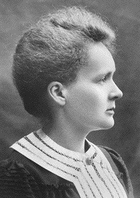
Marie Curie

1867-1934
Her Life Story
Marie Sklodoska Curie was born in Warsaw on
7 November
1867. Daughter of an impoverished secondary-school teacher, she went through
general education whilst also being taught some scientific facts by her father.
During this time she also worked as a governess to help support her elder sister
who studied in Paris. Warsaw was at this rime under Russian rule. Marie became
involved in the student's revolutionary comity and eventually had to leave for Krakow,
which was owned by Australia. 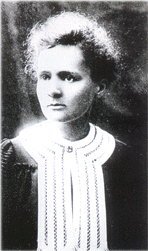
In 1891, Marie moved to Paris to continue her education at La Sorbonne. At this early stage, she was already entranced by chemistry and took several advanced scientific courses. There she met the Physics Professor Pierre Curie, renowned for his work on the piezoelectric effect, and the year after that they married. The discovery of X-rays by Wilhelm Roentgen and Henri Becquerel's discovery of radioactivity in 1896 inspired Marie to chose this new field as the subject of her thesis and her further research. She later persuaded her husband to join her in this field.
Marie Curie received her doctor of Science in 1903. She also achieved quite remarkable status within the faculty, first succeeding from her husband as Head of the Physics Laboratory and then, following his death in a streetcar accident in 1906, as Professor of General Physics, becoming the first woman to hold this post. She was also director of the Curie Laboratory of the University of Paris which was founded in 1914.
Marie Curie was the first ever person to receive 2 Nobel prizes. The first in Physics in 1903, along with her husband and Becquerel, for the discovery of radioactivity, and the second in 1911, in Chemistry this time, for the discovery of the radioactive elements polonium and radium.
Throughout her life she remained dedicated to science and its use for the well-being
of all men. She contributed immensely to the installation of a radioactivity
laboratory in her home town of Warsaw, even receiving a gift of $50,000 from
President Hoover donated by the American Friends of Science.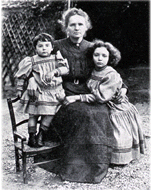
During her busy life, she also found time to bring up her two daughters. The eldest, Irene, went on to become a Nobel prize winner also with her husband, Frederic Joliot. Both Marie and Irene eventually died of leukemia, caused by their overexposure to radioactive materials throughout their lives. Marie died at Savoy, France, on July 4 1934.
Her works
In her initial research into radioactivity, Marie Curie identified the radioactive substances thorium and uranium. She then showed that the radioactivity of any substance was proportional to the amount of radioactive material present. Some samples being extremely radioactive, her husband Pierre and she set out to discover the source.
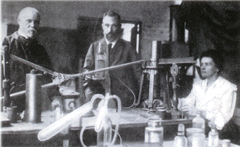
This initial research was carried out in rather poor conditions and both
partners had to teach as well. However, in 1898, polonium was discovered, named
thus after Marie's home country. This was the fruit of long and laborious tests
of the ability of each isolated component to ionize air. This was followed later
that year by Marie's discovery of traces of very radioactive radium. Methods for
its separation from radioactive materials were developed and over four years, the
Curies extracted 1 gram of pure radium from eight tons of raw ore. 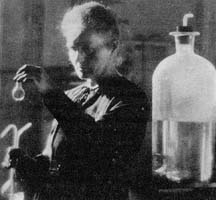 After
Pierre's death in 1906, Marie succeeded in obtaining a pure specimen of radium
which allowed its characterization and the careful study of its properties.
After
Pierre's death in 1906, Marie succeeded in obtaining a pure specimen of radium
which allowed its characterization and the careful study of its properties.
The therapeutic properties of radium were of particular interest. This led to the opening of radium institutes in France and Poland just before World War 1. Here, the further scientific and medical uses of this new species were explored. Marie did much to promote the use of radium to ease suffering. During the war, her daughter Irene and herself dedicated themselves to the treating of the wounded, developing a field system of portable X-ray machines.
Home Lavoisier Laplace Pasteur Du Pont